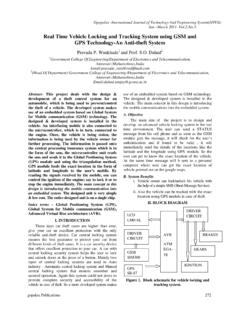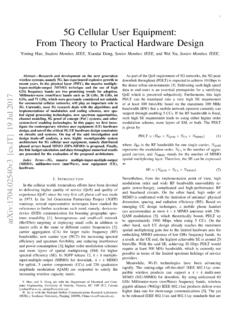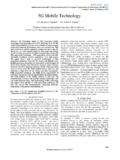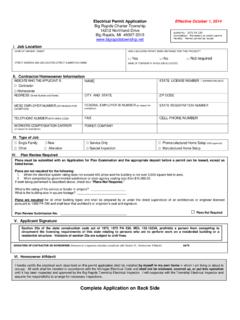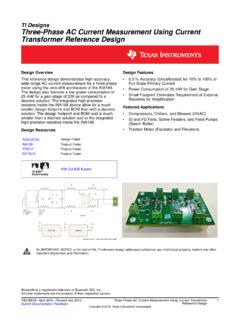Transcription of Eureka sd wp1 - kaltech.co.il
1 Copyright by Eureka Technology Rights Reserved SD, SDIO and MMC InterfacebyEureka Technology 26th, 2011 Copyright (C)All Rights ReservedEureka TechnologyCopyright by Eureka Technology Rights ReservedPage TechnologyIntroductionThis white paper presents very important information for managers, engineers, and system archi-tects who want to broaden his/her knowledge of interfacing with removable data storage are many different aspects of SD and MMC interfacees and this white paper organize theminto a very easy to understand format. One must understand the different characteristics of theseinterface in order to harness the power of the technology and deploy them wisely into new designsand is SD memory interface?Secure Digital (SD) memory card first appeared at the 2000 CES trade show. Within 10 years, it has become the most popular non-volatile removable data storage media for consumer applica-tions. SD memory belongs to the same class of removable data storage device that includes PC card, PCMCIA card, CompactFlash, SmartMedia, MultiMedia Card, Memory Stick and xD.
2 This class of removable data storage device is not intended to replace hard drive. They deliver a frac-tion of the capacity of hard drive at a fraction of the speed performance in a much smaller form factor and also at a smaller unit price. SD device can typically be founded in digtial camera, video recorders, cell phone, printer, laptop computer, car navigation and other contributes to SD Card successes?While PCMCIA was mainly developed for notebook computers, SD card and its other competi-tive devices were targeted to consumer electronics such as cameras and cell phones. SD card has relatively small number of physical pins (5 signals plus clock and power) compared to the earlier PCMCIA and CompactFlash cards. Data is transferred at the moderate speed of 25 MHz (earlier version) up to 208 MHz (latest version), making it fairly inexpensive to manufacture by using matured technologies. At the same time, the synchronous data transfer protocol is very efficient, enabling SD card to delivery adequate data bandwidth requirements for most digital and video applications.
3 The combination of small foot print, lower cost, performance and the backing by several major manufacturers as an open standard enables SD card to become the de-facto standard for consumer electronics data phoneCopyright by Eureka Technology Rights ReservedPage TechnologyWhat is MultiMedia Card (MMC)?MMC is closely related to SD card. The MMC standard precedes the SD standard by several years. The two standards share many common features and have the same physical and electrical specifications. The differences between the two standards are mainly on the software level com-mands. The similarities allow many hosts to accept both MMC and SD cards on the same is the basic SD protocol?SD bus transfers information serially through the bi-directional CMD and DATA pins. Each com-mand packet consists of 48 bits of information on the CMD pin. The command packet includes the command index, argument and CRC check bits. Command is always sent by the host and the response is sent by the card, also through the CMD pin.
4 Most response packets are also 48-bits long. The host is always the command initiator and the card is always the command all commands have associated data transfer. Only read and write commands are accompanied by data transfer. The unit of data packet is called a block. Different block size can be defined by the host. Most data block size is 512 bytes. Data can be transferred using either 1 or all 4 data pins. Each data packet is followed by 16 bits of CRC command processing is heavily state dependent. The card is always in a particular operating state at a given time. Only certain commands are valid in a given state. The host, through the ini-tialization command sequence, changes the card s operating state until it is ready to transfer data. Command and data transfer are synchronized with a clock signal generated by the host. Initially after reset, the host uses the lowest clock rate of 400 KHz to communicate with the card. Internal registers in the card provide information related to the card s capability to the host.
5 By knowing the maximum operating frequency, data bus width and other capability information, the host increases the clock rate for optimal are the different versions of SD and MMC specifications?SD specification is published by SD Association. The founding members of the SD Association are Panasonic, SanDisk and Toshiba. Currently there are about 1000 member companies in the SD first version, , was released in March 2000. This basic version supports 25 MHz bus fre-quency and maximum card size of 2 Gbytes. Data can be transferred in the SD mode (choice of 1-bit and 4-bit data) and the backward compatible SPI mode (1-bit only).The second major revision of the SD interface was released in May 2006. It adds the High Capac-ity SD (SDHC) specification which increases the maximum card capacity to 32 Gbytes. The amount of changes in this revision are not extensive. However, SDHC lays the ground work for future revision changes. The added new card sizes (4, 8 and 16 GBytes) occupy the sweet spot for most picture and video applications.
6 Even after the introduction of the newer capacity in version , SDHC is still the dominate card size in the market by Eureka Technology Rights ReservedPage TechnologyVersion of the SD specification adds a new capacity standard SDXC which supports up to 2 TBytes per card and it also increases data bandwidth through the introduction of the Ultra High Speed (UHS-I) specification. Using the same 4-pin interface, UHS-I supports a maximum single data rate speed of 208 MHz which delivers 104 MByte/sec data rate and a maximum double data rate speed of 50 MHz for 50 Mbyte/sec data is being reviewed by the SD Association and is expected to be released in 2011. Ver-sion adds UHS-II speed version and increases the data rate even higher than version specification was first developed in 1996 by Siemens and SanDisk. The specification was controlled by the MMC Association until 2008. Since 2008, the specification and new releases are controlled by was released in 1999 followed by version in 2001.
7 SD specification is offi-cially compatible with MMC version and eight bit data width were introduced in version in 2003. 8-bit data width gives MMC twice the data bandwidth as SD running at the same speed. However, 8-bit data width is not sup-ported by many host and 4-bit data width is still the most widely used data width for communicat-ing with removable JEDEC took over the MMC specification, embedded MMC (eMMC) was introduced as ver-sion eMMC is intended for on-board application where the eMMC device is mounted on printed circuit board (PCB). Other than the mechanical form factor, eMMC and MMC shares the same features and latest eMMC specification is version Since version , boot mode is supported to allow the device to be used as the boot ROM. DDR data rate is also introduced. The highest bandwidth is 8-bit DDR running at 50 MHz which delivers 100 MByte/sec, giving it the same data rate as SD card running at 4 times the clock rate. The following table summarizes the data rate of different versions of both buses: SD and MMC versionsRevisionMax Clock FrequencyData RateSD to MByte/secSD to MHz25 MByte/secSD MHz104 MByte/secMMC to 320 MByte/secMMC to MHz50 Mbyte/secMMC Mhz100 Mbyte/secCopyright by Eureka Technology Rights ReservedPage TechnologyPerformance: Bandwidth vs.
8 Speed maximum data rate (104 MByte/sec for SD and 100 MByte/sec for eMMC) is not always a true measure of performance of the device. The data rate only specifies the performance of the card when it is transferring data. It does not give any indication how long the host need to wait for the initial data transfer after a command is issued. The longer is the waiting time, the lower is the usable bandwidth. For sustained data transfer, it is just as important to reduce the response time as to increase the clock data storage in the card is implemented by NAND Flash memory cells, the ultimate perfor-mance is dictated by the memory technology as well as the memory architecture. To read data from NAND Flash, the page needs to be opened first and there are a few tens of microseconds of wait time to open a page. Until the page is opened, no data can be read. For writing to the NAND Flash, after a page is transferred to the device, it takes a few hundred microseconds to a few milli-seconds to program the data into the NAND Flash.
9 New operation may not be allowed until the programming is are many factors affecting performance of NAND Flash and SD cards. Single level cell (SLC) NAND Flash has less page open time and program time compared to multi level cell (MLC) NAND Flash but MLC has larger capacity and lower per bit price. Multiple channels architecture improves performance by overlapping the page open and program time of one chan-nel with the data transfer time of another channel, thus reducing the overall down time. Other fac-tors such as controller efficiency and error correction algorithm also affect transfer rate measuresWait time until the next commandWaiting time to open a pageRead AccessWrite AccessSpeed class measures overall performanceOverall read timeperformance only at this regionCopyright by Eureka Technology Rights ReservedPage TechnologyIn order to provide the user with a true measure of usable performance of the SD card, the SD specifications since version define several speed classes that each card must belong can see that there are big differences between the data rate defined by the clock rate and the sustained bandwidth defined by speed class.
10 The differences are reflection of the performance of the NAND Flash storage technology, not a limitation of the SD bus protocol. By the same token, one can improve the performance of a SD card design by improving the memory design without using the highest clock rate of the SD is SDIO and SD combo?SD bus specification defines three card types: memory only card, IO card (SDIO) and card com-bining memory and IO functions (SD combo). SDIO is an extension of the SD specification designed for IO only devices. New commands are defined in SDIO specification while some memory only features are removed. For example, SD memory card has a programming state which accounts for the programming state (in addition to read and write) of the NAND Flash device. SDIO device does not have programming IO functions such as SDIO Wi-Fi or bluetooth controller can be implemented in SDIO card format. The SDIO specification supports multi-function architecture. Each function can operate independently and has its own memory space.

